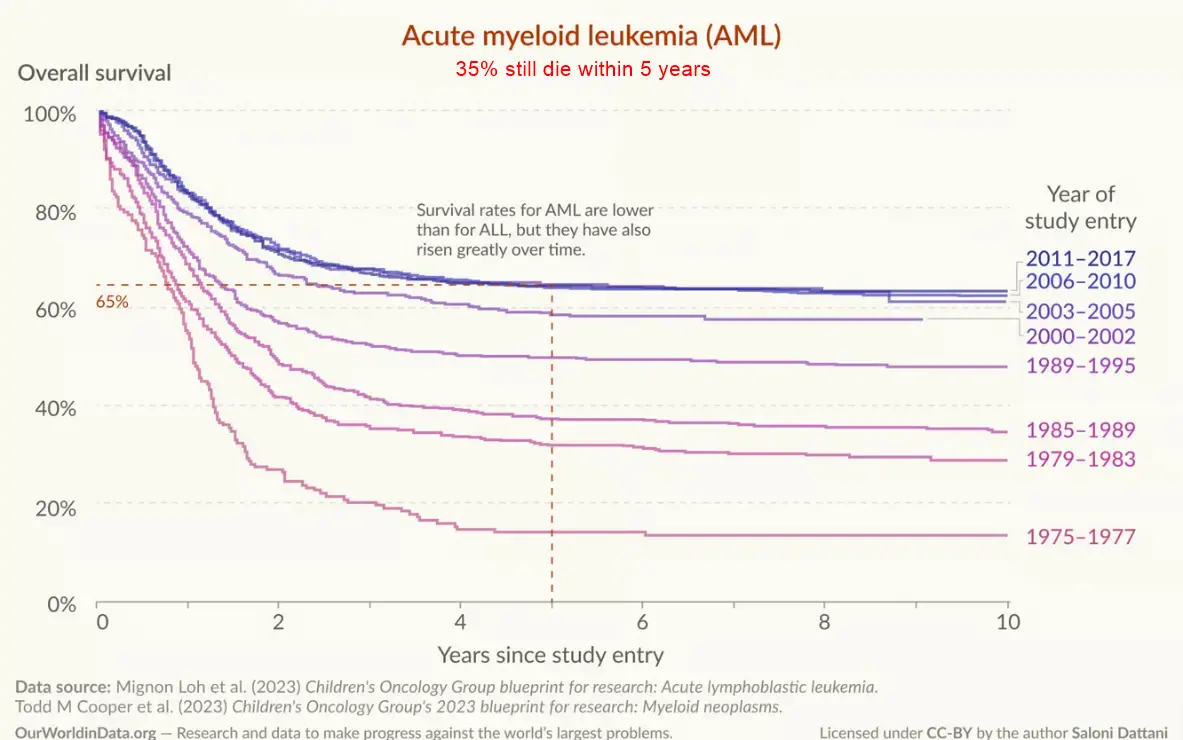After Vitamin D treatment, often need on-going Vitamin D (Childhood Leukemia in this case)
Vitamin D Supplementation in Childhood Leukemia Survivors - Perplexity AI
Yes, children who have been cured of childhood leukemia still have an increased need for vitamin D supplementation and monitoring even after treatment completion. This increased need stems from multiple factors related to their previous cancer treatment and ongoing vulnerability to vitamin D deficiency.
High Prevalence of Vitamin D Deficiency in Cancer Survivors
Research consistently demonstrates that childhood cancer survivors, including leukemia survivors, have significantly higher rates of vitamin D deficiency compared to healthy children. Studies show that:
Between 35.9% to 76% of childhood cancer survivors have vitamin D deficiency 1 2
Long-term survivors maintain elevated risk for vitamin D anomalies compared to the general population 3
The prevalence remains high even years after treatment completion 1 4
A comprehensive study of 206 childhood cancer survivors found that 35.9% had vitamin D deficiency and 46.6% had vitamin D insufficiency , with prevalence rates higher than reported in healthy Thai children 1.
Treatment-Related Effects
Cancer treatment creates lasting effects that impact vitamin D status:
Corticosteroid exposure during treatment affects long-term bone health and vitamin D metabolism 5
Chemotherapy-induced organ damage to liver and kidneys can impair vitamin D synthesis and metabolism 6
Radiation therapy may cause lasting effects on vitamin D metabolism pathways 4
Lifestyle and Physical Factors
Childhood cancer survivors often maintain behaviors that limit vitamin D production:
Reduced outdoor activities due to ongoing health concerns or treatment-related fatigue 1
Sun avoidance habits developed during treatment to prevent photosensitivity reactions 5
Dietary restrictions that may limit vitamin D intake 1
Higher rates of obesity , which is associated with vitamin D sequestration in fat tissue 1 4
Bone Health Complications
Three-fold increased risk of reduced bone mineral density in survivors with vitamin D deficiency 4
Increased fracture risk, particularly concerning given that survivors already have compromised bone health from treatment 8 9
Long-term Health Risks
Research indicates that vitamin D deficiency in cancer survivors may be associated with:
Increased risk of secondary malignancies 7
Compromised immune function 2
Cardiovascular complications 7
Poorer long-term survival outcomes 6
Monitoring Guidelines for survivors
Leading medical organizations recommend:
Regular screening of 25-hydroxyvitamin D levels in childhood cancer survivors 5
Annual monitoring particularly for survivors who received corticosteroids, high-dose methotrexate, or stem cell transplant 5
Risk-based screening focusing on high-risk survivors with elevated BMI, older age, or non-Caucasian ethnicity 5
Supplementation Protocols
Current evidence supports:
Standard dietary vitamin D/calcium intake following national guidelines 8 9
Targeted supplementation for survivors with documented deficiency to maintain levels ≥20 ng/mL year-round 8 9
Higher supplementation doses may be needed compared to healthy children, with some evidence suggesting 400-600 IU daily requirements 10
Special Considerations for Leukemia Survivors
Survivors of childhood leukemia face particular challenges:
ALL survivors show persistent vitamin D deficiency rates of 32.7% to 71.8% in various studies 1
Corticosteroid exposure during leukemia treatment creates lasting effects on vitamin D metabolism 5
Higher risk of bone complications due to treatment intensity makes vitamin D adequacy more critical 11 5
Clinical Practice Implications
Healthcare providers caring for childhood leukemia survivors should:
Implement routine vitamin D screening as part of survivorship care plans
Monitor vitamin D levels annually or more frequently in high-risk survivors
Provide targeted supplementation based on individual risk factors and blood levels
Educate families about the importance of ongoing vitamin D monitoring
Consider higher supplementation doses than general population recommendations when deficiency is identified
Conclusion
Childhood leukemia survivors maintain an increased need for vitamin D supplementation and monitoring throughout their lives . This need persists due to treatment-related effects on vitamin D metabolism, lifestyle factors developed during treatment, and the higher health consequences of deficiency in this vulnerable population. Regular screening and appropriate supplementation are essential components of comprehensive survivorship care to optimize bone health and overall long-term outcomes 7 8 1 9 3 5.
References
https://www.pharmacytimes.com/view/vitamin-d-deficiency-more-prevalent-in-childhood-cancer-survivors
https://cllsociety.org/2024/10/more-vitamin-d-in-early-cll-improves-treatment-free-survival/
https://www.sciencedirect.com/science/article/abs/pii/S0261561415000114
https://healthtree.org/aml/community/articles/a-review-of-vitamin-d-for-aml
https://www.sciencedirect.com/science/article/pii/S2473952924002866
https://www.cancer.gov/about-cancer/causes-prevention/risk/diet/vitamin-d-fact-sheet
https://www.cancer.org/cancer/childhood-cancer/late-effects-of-childhood-cancer-treatment.html
https://www.sciencedirect.com/science/article/abs/pii/S0261561418300694
https://asean-endocrinejournal.org/index.php/JAFES/article/view/1403
https://www.myleukemiateam.com/resources/vitamin-d-and-leukemia-benefits-and-uses
https://www.wcrf.org/about-us/news-and-blogs/vitamin-d-and-fatigue-in-colorectal-cancer-survivors/
https://www.endocrine.org/clinical-practice-guidelines/vitamin-d-for-prevention-of-disease
https://yvm2020.authorea.com/users/389045/articles/503704/download_latex
https://www.sciencedirect.com/science/article/pii/S0960076023000638
https://journals.plos.org/plosone/article?id=10.1371%2Fjournal.pone.0129901
https://www.cancer.gov/types/childhood-cancers/late-effects-pdq
35% of children with acute leukemia still die within 5 years (low Vitamin D?)

See related in VitaminDWiki
Cancer in children (Leukemia) more likely to recur if 20-30 ng of vitamin D – Nov 2022
Preterm births reduced by Vitamin D - many studies
- "Asked Chat-GPT: "What health problems do preemies have as adults?" (Dec 2023)"
People with Multiple Sclerosis have blunted responses to Vitamin D supplementation - Jan 2024
Autistics have half of the response to Vitamin D – RCT Oct 2018
